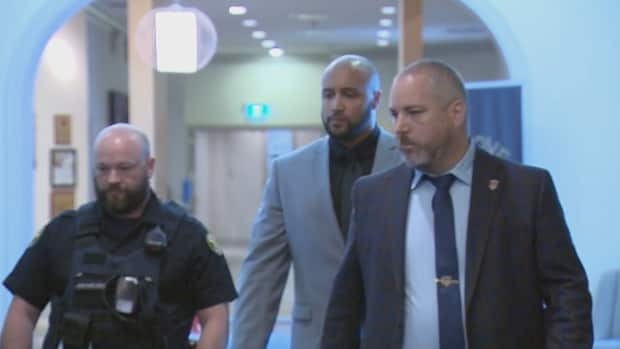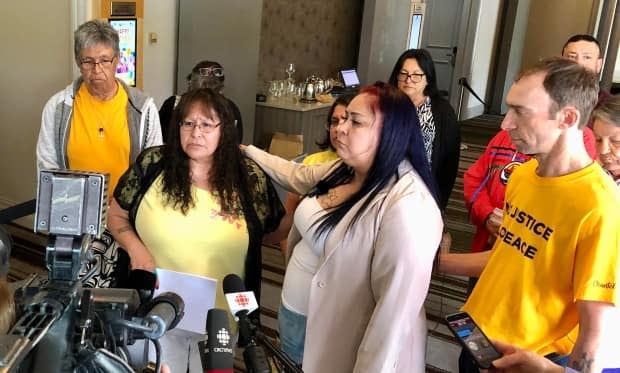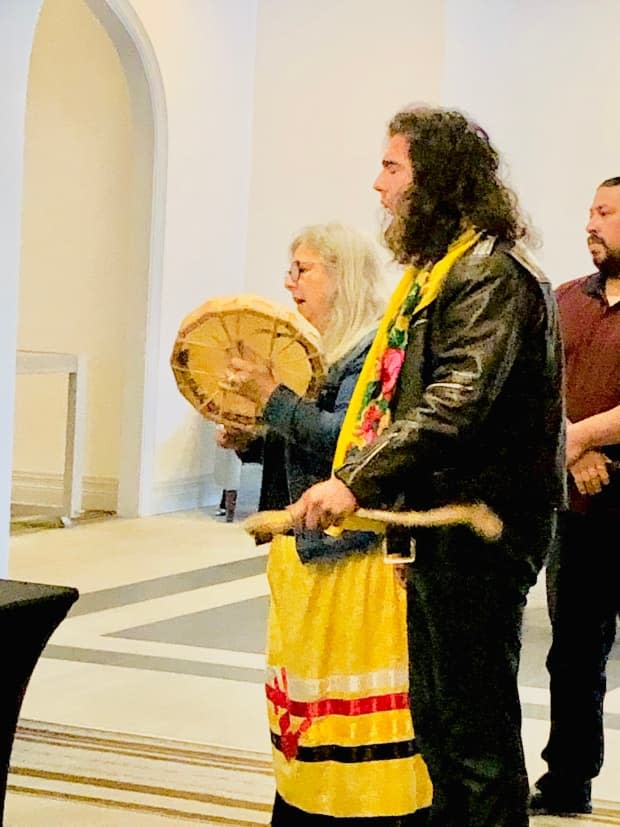'Heavy day' for family of slain Chantel Moore as officer who shot her testifies at inquest

It was a "heavy day," Martha Martin said at the end of the second day of the inquest into her daughter's death.
Chantel Moore, of Tla-o-qui-aht First Nation in British Columbia, was 26 when she was fatally shot on June 4, 2020, by an Edmundston police officer who'd been dispatched to check on her well-being.
Moore's family members were distraught during the testimony Tuesday, hearing for the first time from their daughter's killer.
The family received support, including drumming and smudging, from members of the Indigenous community attending the inquest in Fredericton.
Well-known Wolastoqi singer Jeremy Dutcher made an appearance in the morning. He sang as family members proceeded through security into the conference room.
WATCH | Chantel Moore family's emotional arrival at second day of inquest into her death
Several police officers testified on Tuesday, beginning with the man who shot Moore.
Const. Jeremy Son said his purpose in going to Moore's apartment in Edmundston was to see if she was safe, but after speaking to her ex-boyfriend, Jonathan Brunet, and her mother, he didn't think the call was urgent.
Brunet had told Son that Moore sometimes would send him "inappropriate" messages when she was drinking. But that night the messages seemed bizarre and worrisome. Possibly someone else had her phone. He didn't want to take a chance she could be in danger.
Events transpired in seconds
Son said he arrived on the scene alone and let dispatch know where he was. He did not have the lights on his cruiser activated, so a dash cam video and audio recording system were not activated either.
Son said when he got to the top of the stairs to the apartment, he saw the television on inside and a woman lying on the couch in front of the window. Her phone was in front of her, and it was lighting up as if from notifications.

She seemed to be alone, he said. He knocked on the window several times but she didn't react. He didn't recall whether he announced aloud that he was a police officer.
He tried to turn the door knob, but the door was locked, he said.
A fellow officer, Marc Bouchard, had arrived and was seated in his patrol car in the parking lot below.
Son knocked again. A neighbour with whom Son was acquainted opened his apartment door and said hello, then went back inside.
Son knocked again at Moore's window and saw she had woken up. He radioed that in.
Even once she woke up, she seemed to be searching for the source of the sound, so he kept knocking.
When it seemed she'd seen him, Son said, he pointed his flashlight at his uniform to show he was a police officer, and he pointed to the door.
The next events transpired within a few seconds, he said.
He fired 4 times in quick succession
Moore looked at the door and "calmly" got up, said Son, moving toward the kitchen with a blanket around her. He took a few steps toward the door.
Everything seemed normal, said Son, until he saw through the door that she picked up something metallic from the kitchen counter. Then she quickly came to the door, he said, with an angry look on her face.
"I couldn't understand what was going on, because it seemed like the reaction had changed," Son testified.
Seeing that she had picked up a possible weapon he took out his weapon as well, he said.
She opened the door and with the knife in her hand and was moving toward him, Son said.
He said he told her a couple of times to drop the knife.
There were boxes on the balcony and he was tripping as he backed up, but he got to the railing of the balcony quickly.
Son said he didn't have time to discharge his weapon at her until she stopped about two metres away from him.
He fired four shots in quick succession.
She fell to the ground.
"I didn't know how it got to that point," said Son. "There was no reason this should have happened. I couldn't understand how it changed so drastically. It happened so quickly. There was no more reaction time."

Son said according to his training, as soon as there is a risk of serious injury or death, it's the service weapon that should be used.
"We need to stop the threat as quickly as possible to avoid those consequences," he said.
When Moore fell, Son said, he put away his weapon. He could hear Moore's blood bubbling out and could see it pooling quickly on the balcony floors.
Sgt. Marc Bouchard, who arrived on the scene about 30 seconds earlier, according to his own testimony, advised the police station what had happened, said Son.
Bouchard said he also called for an ambulance.
They quickly turned her body over, said Son, and applied pressure to try to stop the bleeding. Moore's eyes were open and looking around everywhere, he said. He tried to talk to her and take her pulse.
Son lost track of the time, but at some point he could see her eyes had become fixed. He asked Bouchard to check for a pulse and Bouchard said he found none.
Son said Bouchard took his weapon and told him to go down the stairs. He said they went to the station in his patrol car, and he turned in the rest of his equipment.
Son didn't have a Taser
Son confirmed that pictures shown on a projection screen were of the uniform and equipment he had on that morning. The word police was clearly marked on his chest in big white letters and on his ball cap. Besides his service Glock 40, he also had pepper spray, a baton and handcuffs.
Son said he was trained to use a Taser and to instruct others in its use. But he didn't have one that night because a fellow officer had the only functional one. Plus, that Taser didn't fit him properly.
He said he didn't think it would have made a difference to the outcome if he'd had a Taser that night because Tasers are not appropriate to use when there's an immediate safety risk.
Today the force has four Tasers in working order, said Son. The policy says if an officer is trained in its use they should carry one on patrol.
He said it might have made a difference if a second officer had gone up the stairs to the apartment balcony with him.
In response to questions from the jury, Son said he was trained to always target the centre of the body when shooting, and there's no prescribed number of times to fire his weapon. That's determined on the spot by the officer.
Other Edmundston police on scene
Other officers who were on patrol duty that night also testified Tuesday.
Sgt. Marc Bouchard said he got to the parking lot of Moore's building at about 2:35 a.m. and Son was already there.
He could see Son's flashlight shining through the window into the apartment, he said, and heard him knocking on the window.

He lost visual contact with him for about two seconds then heard Son saying, "Drop your knife, drop your knife," and saw him backed up against the balcony railing.
Bouchard said he got out of his car to go help and heard four gunshots.
He ran up the stairs, called in that shots were fired and requested an ambulance.
When he got up to the balcony he saw Moore's body face down.
Son asked him for latex gloves, put them on, turned the woman over and started doing compressions.
Bouchard said he saw blood on the balcony floor, checked for a pulse and Moore didn't have one.
Const. Cedric Volpé then arrived on the scene, said Bouchard, and he asked him to check the apartment to see if anyone else was inside.
Paramedics then arrived, said Bouchard.
Bouchard said he seized Son's weapon, uniform and equipment and secured them in a locker at the station.
He and an inspector then went to inform Martin of her daughter's death.
Coroner has questions
Bouchard said it was only after Chantel Moore's death that he received training in Taser use.
Like Son, he said he didn't activate his dash cam recording system when he arrived at Moore's apartment building.
He stated the force is testing out two different types of body-worn cameras.
Coroner Emily Caissy has been giving Moore's family a chance to submit questions to each witness.
In response to one, Bouchard said Tasers had been available to Edmundston police for many years. He wasn't sure whether the gear had ever been upgraded or replaced.
Caissy herself asked Bouchard if he could specify the reason for the wellness check.
He said as far as he knew Moore wasn't in emotional distress. His impression was that the complainant wasn't sure whether Moore was alone in the apartment and might be in danger.
The presiding coroner also had questions for Cedric Volpé, the third officer on the scene.
She asked whether he was aware of what to do if someone was in cardiac arrest.
Volpé said the policy is to provide first aid and take resuscitation measures until paramedics arrive and advise whether to stop.
But paramedic Ken Michaud testified no one was working on Moore when he arrived.
Michaud said when he checked her vitals and found no signs of life, he left the immediate area and alerted the coroner and remained on scene another 30 to 45 minutes to see if anyone else needed medical assistance.
Steak knife found on balcony
Investigative coroner Denis Desjardins testified he attended Moore's apartment, noted it was a homicide and said investigators would have to be called in from outside agencies.
Later, when Moore's body was being moved, Desjardins said he observed gunshot wounds on the body and saw blood on the floor of the balcony.
An investigator from the RCMP moved a piece of cardboard on the balcony, said Desjardins, and a steak knife was found beneath it.

He noted Moore's time of death as 2:44 a.m. as determined by Michaud, the paramedic.
An outside investigator from the RCMP, Mark Blakely, who was one of the people brought in to process the crime scene, said nothing seemed amiss inside the apartment. He noted a knife was missing from a block in the kitchen, and Moore's cellphone was near the door and seemed to be still playing music through a connected device.
'We've had enough'
Following the day's testimony, Wolastoqi elder Alma Brooks noted that much of the day's focus was on Tasers, training and broken equipment.
"What are they going to do?" she said, "Reward them with more money to never address any violence or police corruption or anything that would make any significant change in the system?"
Brooks and several other supporters of Moore's family read aloud the names of several other young Indigenous people who have been killed by police or died in police custody.
That's a fate shared by an estimated 1,813 people since 1987, said Moore's mother.
"We've had enough," said Martin. "We want to see change."
The inquest continues on Wednesday.

 Yahoo Movies
Yahoo Movies 